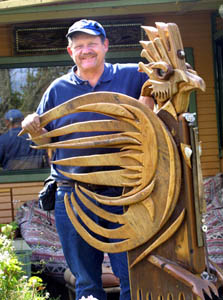![[MetroActive Arts]](/gifs/art468.gif)
[ Arts Index | Santa Cruz | MetroActive Central | Archives ]
Photograph by George Sakkestad
Chance Encounters
South County artist creates sculptures from the lost and the found
By Andrea Perkins
BOB LYONS is a chronic collector, a curator of the obsolete. The artist's Freedom backyard is a wilderness of old gas pumps, wooden apple juicers, ancient oil drill tips and other rusted objects nestled amid flowerbeds. An old casing for an incinerator that Bob found in the ocean collects rainwater near a bonfire pit decorated with glass insulators culled from telephone company dumpsters.
"I'm really into rust," Lyons says. "I like to see nature taking back what humans have refined."
"What's that?" I ask, pointing to a hunk of metal poking out from behind a shrub. "I don't always know what the things are," he says.
Bob makes art out of things he finds--things like catcher's vests, sea lion bones, thermometers, window frames, heater grates, rusted spoons and porpoise skulls. He sniffs out each object's potential and places it next to another object, according to some ineffable design that only he understands. The results are large mosaics crammed with history, which themselves become artifacts of a radical imagination.
Bob inherited the passion for collecting what others discard from his uncle, whom he describes as a "Croatian cowboy who worked for the phone company." This uncle was appalled at how much stuff the phone company threw out, so he started gathering it. "This piece is dedicated to him," says Lyons, indicating a giant tile-framed panel dominated by an old motorcycle seat surrounded by artfully placed poker chips, fishing lures, arrows, golf clubs and old Coors beer cans. The effect is heightened by a frayed spiderweb, a chance collaboration.
Indeed, if there is one unifying theme in Bob's work, it is the significance of chance happenings. "I am very aware of happenstance and serendipity," he says. He also likes the way time and weather leave their mark on things. That's why he puts all of his work outside where it can get rained on. "It's all really held up considering I just used old carpenter's glue."
A totemesque sculpture called The Eagle looms from a corner of the deck, radiating a bright animal intensity. The rich, shellacked wood is peppered with shells and beach glass. Eyes made from broken insulators gleam in the fading daylight.
Lyons says the problem with art is "it's easy to overemphasize your own ego and lose sight of why you're doing it." That's one reason why he hasn't exhibited his work much. Unlike most artists, Lyons is not tormented by the need for exposure. His backyard is his permanent gallery, though he has shown his work at the Pajaro Valley Art Gallery.
Also, his real job as a teacher keeps him busy. Lyons heads the "opportunity class" program at Rolling Hills Middle School, which offers troubled students one last chance to stay in the mainstream school system. "I've been trying lots of different ways to nurture and look for the positive in people and inspire them and help them create," says Lyons, who often takes students on painting trips to the Watsonville Sloughs.
Bob has had a lot of jobs. He used to be an electrician and before that he was a garbage collector, a job that allowed him to indulge his "junk"-gathering habits unhindered. These days he likes to scavenge beaches, especially right after storms. "I like things that have been rounded, altered."
Lyons doesn't hesitate when asked about influences. "Noah Purifoy," he says. Lyons met Purifoy in the '60s when the latter organized the seminal collaborative piece, 66 Signs of Neon, using objects found in the still-smoldering rubble of the Watts riots in 1965. "Purifoy had a theory behind [the piece]," says Lyons, "that had to do with the healing of the soul. We live in a hierarchical society where a lot of people are considered garbage. Finding objects thought of as refuse is also about refinding people."
The Watsonville Sloughs are another source of inspiration for Lyons. In 1990, he co-founded the environmental group, Watsonville Wetlands Watch. Lyons has also been instrumental in organizing the removal of garbage from ancient Native American burial grounds and has planted willows in the sloughs.
I am distracted by a large wooden structure in the middle of the yard, a playhouse Bob made for his children, who are now adults. Upon investigation, I find that it's more than just a playhouse; it's a monument, an everlasting testimony not only to Lyons' skill as a rummager, but to his unique understanding of children. "Kids love pushing buttons," he says. Affixed to the two-tiered, ramshackle edifice are old radios, typewriters, telephones, microphones, license plates, parking meters and birdhouses. An old conveyor belt (found outside of the Green Giant warehouse) functions as a slide. A huge tractor tire provides a perfect hiding place. Ornate piano legs protrude from the corners like spires in some exotic city. "It could be a boat, or it could be anything," says Lyons.
[ Santa Cruz | MetroActive Central | Archives ]
Copyright © Metro Publishing Inc. Maintained by Boulevards New Media.
![]()
 Refusenik: Bob Lyons' backyard serves as a permanent gallery for an array of artworks fashioned from scavenged, rummaged and rescued objects.
Refusenik: Bob Lyons' backyard serves as a permanent gallery for an array of artworks fashioned from scavenged, rummaged and rescued objects.
From the April 18-25, 2001 issue of Metro Santa Cruz.